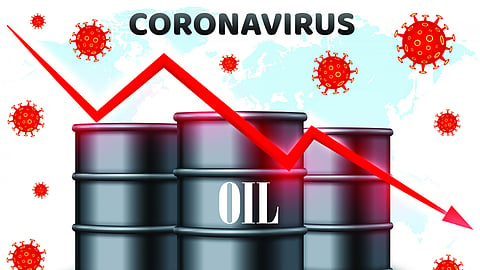GCC Economies Facing a 'Perfect Storm'
The COVID-19 pandemic has radically changed the prospects of the global economy for the short-, the medium- and potentially for the long-term.
The Gulf countries face a somber outlook as well, with the GDP of the region expected to contract by 5.9% in 2020 compared to 2019.
The Gulf countries whose economies remain highly dependent on hydrocarbon are ahead of “perfect storm” like scenario: a humanitarian crisis, that morphed into a global demand shock and pushed oil prices into a free-fall. A historical oil production cut agreement barely managed to improve prices.
Fiscal deficits of the region are expected to widen significantly in 2020 and remain in the negative territory in the short term with most of the countries still trying to recover from the 2014 oil price collapse.
To make things worse, the gulf authorities had to generously intervene through fiscal and monetary support packages to alleviate some of the pain caused by this crisis, adding more pressure on their budgets.
UAE Exports Remain Resilient Amid COVID-19 Pandemic
With foreign reserves quickly depleting and raising pressure on their pegged currencies, the Gulf countries would have to tap the international markets and their sovereign wealth funds to fund the fiscal deficits, highlighting once more the eminent need to decouple the region’s budgets from hydrocarbon revenues.
The containment measures imposed in more than 180 countries curtailed mobility, aviation and trade which account for nearly 60 percent of global oil demand. As per the International Energy Agency (IEA), by the end of March, global road transport activity was almost 50% below the 2019 average and aviation 60% below.
Oil demand is set to decline by 29mb/d in April and by a smaller magnitude in May as most countries will remain under restrains. As such, by end of 2020, the oil demand gap (oil demand minus oil supply) would remain large. In fact, global oil demand is expected to fall by more than 15 mb/d year-on-year in 2020.
Investments in Energy Sector See Biggest Drop in History
The region’s GDP is forecasted to decline by 5.9% in 2020 and then to recover by 2.2% in 2021. This is in line with the IMF Longer Outbreak Scenario and not their baseline scenario which is a V-shape recovery.
Depending on the efficiency of the containment measures and the number of new COVID-19 cases, the region is subject to three possible scenarios for 2020 and 2021; however, all three would result in a significant GDP contraction in 2020.
Under the U shape recovery scenario in 2020 (extended contraction, slow recovery), Q2 is set to witness the sharpest GDP decline, with the OPEC+ agreement going into effect. Economic weakness would stretch into Q3 and Q4 would see a shy return of non-oil activity, especially for the services sectors.
The V shape recovery scenario (deep contraction, fast recovery) is more of an optimistic scenario, where the deep economic contraction is in Q2 only, followed by a stronger recovery in Q3.
However high uncertainty reigns if the economy gets opened up too fast leading to a second wave of COVID-19 cases. Then we are faced with a W-shape (2nd contraction in Q4 due to new peak).
GDP of the gulf region is expected to recover modestly in 2021 as oil production increases slightly and non-oil GDP improves by 2.1% y/y.
Read More: $5 Trillion Injection Needed to Revive Global Trade Volumes: ICC


